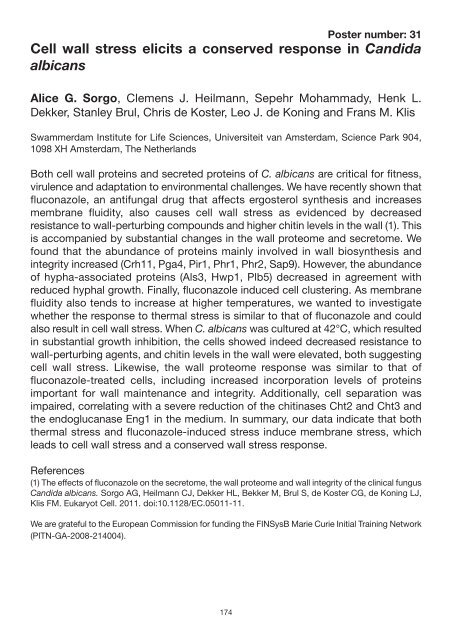Candida Infection Biology – fungal armoury, battlefields ... - FINSysB
Candida Infection Biology – fungal armoury, battlefields ... - FINSysB
Candida Infection Biology – fungal armoury, battlefields ... - FINSysB
Create successful ePaper yourself
Turn your PDF publications into a flip-book with our unique Google optimized e-Paper software.
Poster number: 31<br />
Cell wall stress elicits a conserved response in <strong>Candida</strong><br />
albicans<br />
Alice G. Sorgo, Clemens J. Heilmann, Sepehr Mohammady, Henk L.<br />
Dekker, Stanley Brul, Chris de Koster, Leo J. de Koning and Frans M. Klis<br />
Swammerdam Institute for Life Sciences, Universiteit van Amsterdam, Science Park 904,<br />
1098 XH Amsterdam, The Netherlands<br />
Both cell wall proteins and secreted proteins of C. albicans are critical for fitness,<br />
virulence and adaptation to environmental challenges. We have recently shown that<br />
fluconazole, an anti<strong>fungal</strong> drug that affects ergosterol synthesis and increases<br />
membrane fluidity, also causes cell wall stress as evidenced by decreased<br />
resistance to wall-perturbing compounds and higher chitin levels in the wall (1). This<br />
is accompanied by substantial changes in the wall proteome and secretome. We<br />
found that the abundance of proteins mainly involved in wall biosynthesis and<br />
integrity increased (Crh11, Pga4, Pir1, Phr1, Phr2, Sap9). However, the abundance<br />
of hypha-associated proteins (Als3, Hwp1, Plb5) decreased in agreement with<br />
reduced hyphal growth. Finally, fluconazole induced cell clustering. As membrane<br />
fluidity also tends to increase at higher temperatures, we wanted to investigate<br />
whether the response to thermal stress is similar to that of fluconazole and could<br />
also result in cell wall stress. When C. albicans was cultured at 42°C, which resulted<br />
in substantial growth inhibition, the cells showed indeed decreased resistance to<br />
wall-perturbing agents, and chitin levels in the wall were elevated, both suggesting<br />
cell wall stress. Likewise, the wall proteome response was similar to that of<br />
fluconazole-treated cells, including increased incorporation levels of proteins<br />
important for wall maintenance and integrity. Additionally, cell separation was<br />
impaired, correlating with a severe reduction of the chitinases Cht2 and Cht3 and<br />
the endoglucanase Eng1 in the medium. In summary, our data indicate that both<br />
thermal stress and fluconazole-induced stress induce membrane stress, which<br />
leads to cell wall stress and a conserved wall stress response.<br />
References<br />
(1) The effects of fluconazole on the secretome, the wall proteome and wall integrity of the clinical fungus<br />
<strong>Candida</strong> albicans. Sorgo AG, Heilmann CJ, Dekker HL, Bekker M, Brul S, de Koster CG, de Koning LJ,<br />
Klis FM. Eukaryot Cell. 2011. doi:10.1128/EC.05011-11.<br />
We are grateful to the European Commission for funding the <strong>FINSysB</strong> Marie Curie Initial Training Network<br />
(PITN-GA-2008-214004).<br />
174


